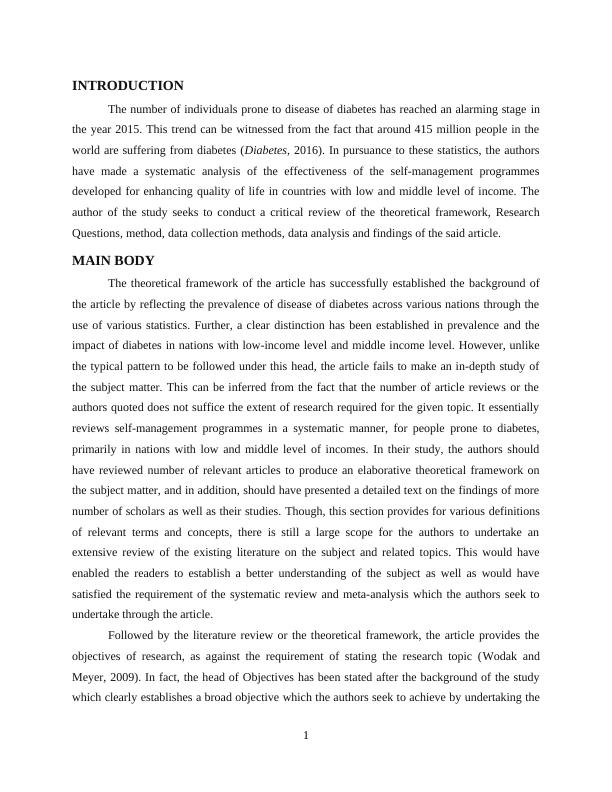Ask a question from expert
Effectiveness of Peer-led Diabetes
7 Pages2491 Words171 Views
Added on 2020-01-07
Effectiveness of Peer-led Diabetes
Added on 2020-01-07
BookmarkShareRelated Documents
ARTICLE REVIEW

INTRODUCTIONThe number of individuals prone to disease of diabetes has reached an alarming stage inthe year 2015. This trend can be witnessed from the fact that around 415 million people in theworld are suffering from diabetes (Diabetes, 2016). In pursuance to these statistics, the authorshave made a systematic analysis of the effectiveness of the self-management programmesdeveloped for enhancing quality of life in countries with low and middle level of income. Theauthor of the study seeks to conduct a critical review of the theoretical framework, ResearchQuestions, method, data collection methods, data analysis and findings of the said article.MAIN BODYThe theoretical framework of the article has successfully established the background ofthe article by reflecting the prevalence of disease of diabetes across various nations through theuse of various statistics. Further, a clear distinction has been established in prevalence and theimpact of diabetes in nations with low-income level and middle income level. However, unlikethe typical pattern to be followed under this head, the article fails to make an in-depth study ofthe subject matter. This can be inferred from the fact that the number of article reviews or theauthors quoted does not suffice the extent of research required for the given topic. It essentiallyreviews self-management programmes in a systematic manner, for people prone to diabetes,primarily in nations with low and middle level of incomes. In their study, the authors shouldhave reviewed number of relevant articles to produce an elaborative theoretical framework onthe subject matter, and in addition, should have presented a detailed text on the findings of morenumber of scholars as well as their studies. Though, this section provides for various definitionsof relevant terms and concepts, there is still a large scope for the authors to undertake anextensive review of the existing literature on the subject and related topics. This would haveenabled the readers to establish a better understanding of the subject as well as would havesatisfied the requirement of the systematic review and meta-analysis which the authors seek toundertake through the article. Followed by the literature review or the theoretical framework, the article provides theobjectives of research, as against the requirement of stating the research topic (Wodak andMeyer, 2009). In fact, the head of Objectives has been stated after the background of the studywhich clearly establishes a broad objective which the authors seek to achieve by undertaking the1

present study. However, there is no mention of the aim with which this research is being carriedout and also the objectives stated does not provide for specific requirement which is intended tobe realized by the authors by carrying out the instant research. In fact, the author should havepresented a clear statement of the aim to be realized by undertaking the study which should havebeen bifurcated or broken in parts to develop the specific objectives to be achieved. Also, thearticle should have explained the rationale behind choosing the topic of research and thephenomenon of interest which cannot be traced anywhere in the whole article. To make thereaders understand the relevance of the topic in the present world, a mention of the rationalerelying on which the subject area was chosen by the authors should have been made in the text ofthe article (Whiting and et. al., 2011). This would have given the authors a grip of the subjectmatter and in addition would have enhanced the level of understanding of each of the conceptspresented. The article has failed to formulate elaborative research questions which could haveenabled them to undertake a more structured and elaborative exploration of the subject. It isimportant to highlight that the article does provide for an objective and two research questions,which reflect a vague understanding of the approach of the research undertaken by the authorsand the results expected to be realized. Furthermore, the authors have not even made use of thePICO framework in formulation of the research questions so stated in the article. This frameworkessentially requires the presence of the following elements – Patient's problem or population (P),Intervention (I), Comparison (C) and Outcome (O) (Shaw, Sicree and Zimmet, 2010). Theauthors on the contrary have stated only 2 questions which in essence only cover theeffectiveness and the impact which can be realized by the application of the said measure.Moreover, the article does not establish any hypothesis on the basis of which the study wasundertaken by the authors. In result of this, the article fails to provide a clear picture of the pointof commencement of the research as well as the suppositions considered by the authors whileundertaking the research. The research method used to carry out the present study is very effective and has enabledthe authors to realize results in spite of the loopholes present under other heads of the article.First of all, the author has made use of the systematic review study protocol which has also beenpublished in PROSPERO International Prospective Register. This has enabled the authors toundertake a systematic review of the self-management programmes which can prove to be2

End of preview
Want to access all the pages? Upload your documents or become a member.
Related Documents
Impact of Fat Diet in Prevention of Diabeteslg...
|16
|3833
|91
Critical Literature Review Introduction Introduction Towards Effective Dissemination of Information on Mental Health Nursing in Wicclg...
|27
|6255
|244
NURS2000: Health Behaviors of Patients Diagnosed with Type 2 Diabetelg...
|7
|1668
|174
Epidemiology: High Protein Diet and the Risk of Type 2 Diabeteslg...
|14
|3930
|82
The Use of Complementary and Alternative Medicine among Women with Type 2 Diabetes in Southeast Asia: A Systematic Reviewlg...
|17
|3840
|150
(PDF) Social Epidemiology Assignmentlg...
|14
|3642
|425